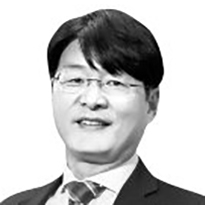Solving labor and management issues like Sweden
Published: 15 Aug. 2024, 20:16

The author is the vice chairperson of the Economic, Social & Labor Council.
The economic environment is turbulent, buffeted by rapid changes and unsettling geopolitics. As the economy has geared into slow motion, companies are rolling back hiring and business. The toll falls heavily on the youth looking to start a career. According to Statistics Korea, it took an average 13.9 months for a Korean under 34 years of age to find his or her first job last year, the longest period for job entry.
The lucky ones should be happy to get the job they want, no matter how long it has taken. Most must settle with short-term contracts or part time. The ratio of temporary, seasonal or daily hires made up 34.4 percent, and those hired on an hourly basis made up 18.7 percent among employed young people. More than half — 59 percent — earned less than 2 million won ($1,474) — below the minimum wage — in their first job. As many as 430,000 twenty-somethings have given up looking for jobs, up 40,000 from last year.
Extending the retirement age is a talking point among the employed, but getting employed in the first place is onerous for the young. In June, 258,000 more people aged 60 or older were employed compared to a year ago, while 135,000 less were employed among those in their 20s during the same period.
The Economic, Social & Labor Council (ESLC), the tripartite committee representing employees, employers and the government, has been addressing issues related to industrial transitions, job discrepancies and labor insecurity. The industrial transition demands responses to changes in the business environment, whereas discrepancies require understanding and cooperation among the participants in the labor market. Both employees and employers agree that the gap between large and smaller workplaces is central to the problem.
Job rewards should differ according to individual endeavors and achievements. But it is a different matter if they hinge on the category of the employer. The labor zone becomes exclusive if there is a clear wall against the outsiders. If the wall cannot come down, the slogan about equal pay for equal work can be in vain.
Hyundai Motor employees are paid an average of 130 million won according to this year’s collective bargaining results. They can work for two more years after retirement if they desire. The company has achieved its bargaining agreement without a strike for six years because the management complied with the union’s wishes.
On the day Hyundai Motor reached an agreement during bargaining talks, the statutory minimum wage was decided at 10,030 won per hour (25.15 million won on a yearly basis) for the next year. The new wage floor would affect the bulk of the labor force, as it goes above 60 percent of the median income. Hires at workplaces with fewer than five employees are not protected by the Basic Labor Act. They work beyond the statutory 52-hour workweek and are not paid for overtime. Many are forced to settle for an extremely short-term contract because employers want to avoid paying for weekends and holidays.
It is natural for the young to prefer large companies bound by legal and union demands. But regular jobs at large companies account for just 15 percent of the work available in Korea. The other 85 percent are provided by smaller companies. People employed at workplaces with five or fewer hires make up 30 percent, or 8 million.
The unions claim that the labor market has become too flexible, while the business sector argues it remains too rigid. The gap between large and smaller companies constitutes the bone of contention. Korean labor regulations are among the most rigid in the world. They are well followed by large companies in which the union organization rate hovers at 46 percent. But they often are no use in ununionized small companies where hires are hard to attract and keep due to poor work conditions, causing a dilemma in labor policy.
The more regulations the government makes, the wider the gap becomes. The shortened workhours and extensions in retirement age entirely benefit workers in large companies, while burdening employers. All these become the cause of conflict between labor and the government.
Labor issues should be settled between employers and employees. The labor side in the ESLC has proposed the adoption of a wage system of restricting wages in lucrative sectors and increasing those in less profitable sectors to balance out the differences. It also demanded a hike in the minimum wage, an inclusion of under-five-hire workplaces in the Basic Act framework and the protection of platform gig workers. The business community has argued for change in the pay system. Both sides have laid out cards that cannot be easily accepted by one another.
Still, they should debate with patience. Sweden experimented with wage policy in 1951 upon agreement between labor and management. The unions of big companies cut the wages and increased those of subcontracted workers. Companies used the extra savings on research and development. When smaller companies had to follow suit with wage increases, weak players who could not afford to do so had to exit. A tripartite committee took care of those who lost their jobs in the restructuring process.
But we must learn from independent problem-solving between labor and management. The unions of large companies must show compassion for the unprotected and ununionized workers. It takes time to untangle complicated structural issues. The participants must persistently debate to find answers through the ESLC platform.










with the Korea JoongAng Daily
To write comments, please log in to one of the accounts.
Standards Board Policy (0/250자)